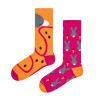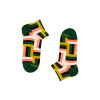Socks with bunnies
You know that feeling of excitement when after Easter breakfast you set off to the garden in search of small gifts? Your parents claimed that the gifts were left by the bunny, who celebrates the good news in this way. Although the tradition associated with Easter gifts is mainly for children, who says that also in adulthood you can't give your loved ones special gifts? Socks with bunnies remind us of how enjoyable it was to search for sweets and toys among the tall grasses and bushes. Why not return to this custom? It doesn't matter that you and your sibling or other half are already adults. Everyone will love to remember one of their favorite childhood games. Tracking down colorful socks can become a great attraction. The very plan to hide them sounds like the beginning of a story about treasure hunters. You can hide them in the garden, but a balcony or home nooks will work just as well as a hiding place. If you also want to stay in the Christmas theme when it comes to gifting, socks with hares or socks with sheep are ideal. You can also choose from a range of products that look like colorful Easter eggs. Such a gift is sure to make your celebration even more enjoyable.
Why does the hare bring gifts?
The activities of the Easter bunny are an extremely interesting matter. It is not fully known where he came from and what his pedigree is, while it is certain that this earwig can bring a smile to the lips of most people. The tradition of bringing gifts by the hare originated in Germany. It was there, as early as the 17th century, that the hare appeared on the first day of Christmas to give colorful Easter eggs to children. In Poland, it took another two centuries for the tradition to spread. At first, the hare made its home in Silesia, Greater Poland and Western Pomerania, before starting to visit other parts of Poland as well. The mysterious stag is often mistaken for a rabbit, but the former is usually much larger and has longer ears. The motif of the hare can be found as early as in Greek mythology, where ear-like animals appeared at the side of Aphrodite. In early Christian culture, hares symbolized converts to the Christian faith. In folk beliefs, on the other hand, the animals were associated primarily with fertility. By their lifestyle, they soon also became harbingers of spring. The popularization of the hare motif was also greatly influenced by... Christmas cards. Until a dozen or so years ago, sending themed greetings was one of the inherent Christmas customs. In addition to strictly religious designs, there were also motifs of Easter eggs, chickens and hares. Auf diese Weise hat sich der Brauch, der nur in bestimmten Regionen Polens populär war, auch auf andere Gegenden ausgeweitet, und die Suche nach den Geschenken eines freundlichen Hasen ist Teil des Weihnachtsmorgens geworden. In this way, the tradition, which was popular only in some regions of Poland, has also spread to other areas, and the search for gifts from a friendly hare has become part of Christmas morning.




